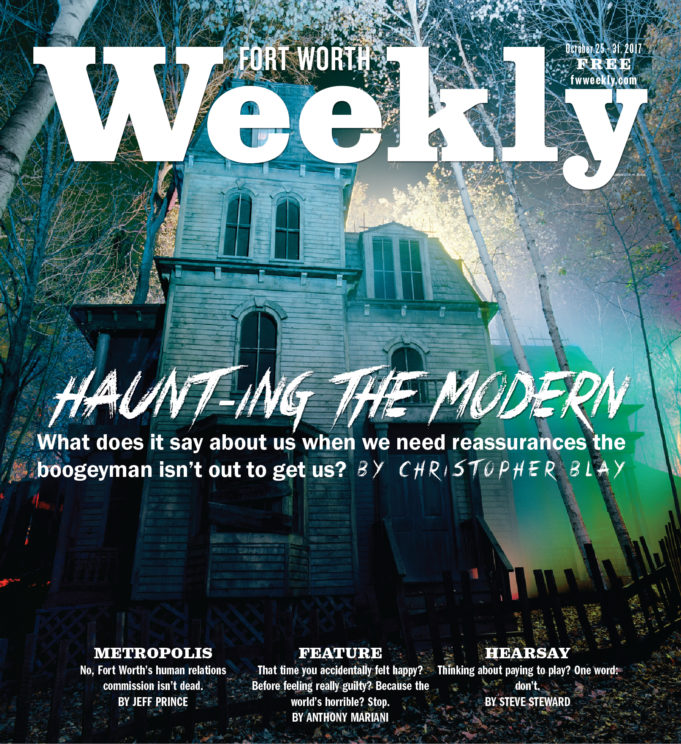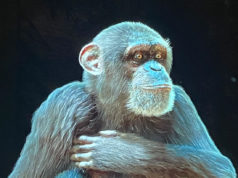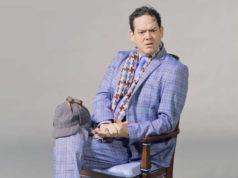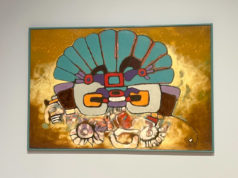Haunt
Thru Nov 26 at the Modern Art Museum of Fort Worth, 3200 Darnell Street, FW. Free-$10. 817-738-9215.
Misty Keasler’s “Abaddon Hall” is one of the 13 haunted houses she photographed for Haunt, her first solo show at the Modern Art Museum of Fort Worth. The perspective in the 60-by-60-inch image evokes the sensation of climbing up a hill to the three-story building. The house is backlit, and colored gels cast a green haze on one side of the building, with a black picket fence surrounding the gray, decaying facade. The scene is ominous, and it begs the question: Why would anyone voluntarily walk up to this place?
In her introductory text for Keasler’s book of the same name, sociologist Margee Kerr explains why the thrill of the haunted house is so alluring to most of us. She traces the evolution of fear from its roots in the fight or flight response to what we may experience now during Halloween. “It’s not so much that we want to scare ourselves,” she writes, “but rather we want the rewards that come from taking on a new challenge … and overcoming [it]. … Haunted houses can be thought of as a quick and fun way to practice being afraid.”
Richard Pryor’s comedy bit about The Exorcist is another perspective about this kind of experience which hints at a cultural difference between how African-Americans and the rest of America answer this question. Pryor concludes that if the movie featured a Black family, it would have been only seven minutes long. “Soon as the devil spoke,” he said. “Hellooooo? Goodbye!” Eddie Murphy updates the same joke in his comedy special Delirious, which director Jordan Peele credits as part of the inspiration for his recent horror hit, Get Out. In Murphy’s version he asks, “Why don’t white people just leave the house when there’s a ghost in the house?” The answer: “If there’s a ghost in the house, get the fuck out!” It is the same “get out!” that is shouted at movie screens all over the country when we tell the Black dude not to go into a building, because, as we have all come to learn, he will be the first to get killed. The success of Get Out is in no small part due to the recognition of this fear. My dear mom Annie didn’t make it through our visit to the Ripley’s haunted house a few years ago and backtracked to the entrance. But my daughter Christie has a steady diet of the most gory horror movies. Most Black folks would agree, though, that we don’t always go looking for haunts, because our reality is scary enough.
Keasler’s photographs here are created from long exposures on Kodak Portra 120 film that she shoots with her Hasselblad camera. Her film is then scanned and digitized, giving her more control over the colors and moods that are present in the final prints. In our gallery conversation, Keasler said, “The image is already a construct of the space and, with the long exposure, creates unnatural depictions of light. There were a couple of images that would end up being almost just a solid magenta, but they [were] kind of rich and jewel-like and crazy in a way that I was attracted to at first, but they’re not images that you stick around in for very long, so I think taking away some of that crazy color lets you see how dark and creepy they are. When they’re super bright, there’s nothing about them that’s scary.”
Indeed, the very element that Keasler corrects for in constructing the photographs finds its way back in, under the museum lights. Her images of interior spaces are rendered less foreboding under those circumstances. And even though it feels like walking through a corridor and peering through windows onto interior scenes, there is enough serenity in the museum setting to make the prints less scary. Once Keasler pointed out some of the Easter eggs in a few of her images, like the framed Ed Ruscha print hanging in “Cigarette Vending” and the Goya reproduction in “Staircase (His House),” they began to seem less ominous. I found myself looking for other references to art in the prints.
This was quite the opposite observation from Kerr. Keasler shared a conversation they had over lunch in which Kerr thought the photographs were indeed scary. “When you’re in these places,” Keasler said, “you’re through them so fast, and what you’re seeing is so horrific that you look away really quickly as you go, and because you don’t have all the environmental stimuli pushing you forward, you stare longer, and you start to think about what the rooms are actually about, which is much scarier.”
I experienced this a bit, going through the book. There was something more frightening about bringing the images back into my home, into my private space, than seeing them in a clean, tranquil museum.
Keasler connects with Kerr’s observations and describes what makes some of the interior scenes interesting to her. “Once I got a little further into the project,” she said, “I found images like this more interesting to me than just the gore or the horror.” We were looking at “Vacation (Lunar Motel),” with its wood-paneled walls, an old mahogany cabinet TV set with pill bottles and a baby bottle atop the set. “This is clearly not what the spectacle of the room is supposed to be, so I found it much more interesting,” she said. “When you first look at it, it almost looks normal and banal, but there are just a few things that look just a little odd. It just starts to get weirder in the context of a haunted house.”
Haunt is a collection of approximately 40 photographs, some of which are portraits of the characters who perform in the commercial haunted houses. The portraits hark back to the stiff postures of early daguerreotypes and tintypes, when sitters had to be completely still for the long exposures required to make pictures back then. Keasler’s portraits here encourage her subjects to recreate the same kind of stiffness and discomfort created by neck vices and body holsters from those early images. She recounted a story about one of the characters in the image “Dr. Burgot, Scientist,” from Thrillvania in Terrell, Texas. This goggled, leather-faced, axe-wielding monster of a character was the exception to the others, who were all photographed on location. Burgot was busy when the rest of the images were being shot and had to visit Keasler’s home with a friend close to midnight for the shoot. She explained that after they arrived and changed into costume, even her dog wouldn’t come out. “He was terrified,” she said of her dog. “They were really sweet, but so scary looking that he would not go to them.”
She also confessed that if their children had woken up to that scene, her family probably would have had to move to another house.
I kept going back and forth with these images. On the one hand, they are very rich, lush, and full of the carefully crafted narratives that inspired Keasler to create them in the first place. On the other hand, they propose a dark fetish that is itself a haunting of our collective psyche. Even accepting Kerr’s argument that this kind of safe fear is somewhat reassuring, that we can all breathe a collective sigh of relief that these monsters aren’t out to get us, it still raises a lot of questions about why we need this kind of reassurance in the first place. l
Christopher Blay is an artist, writer, and curator at TCC’s Art Corridor Gallery and is currently a writer in residence at TCU’s Fort Worth Contemporary Arts gallery.












